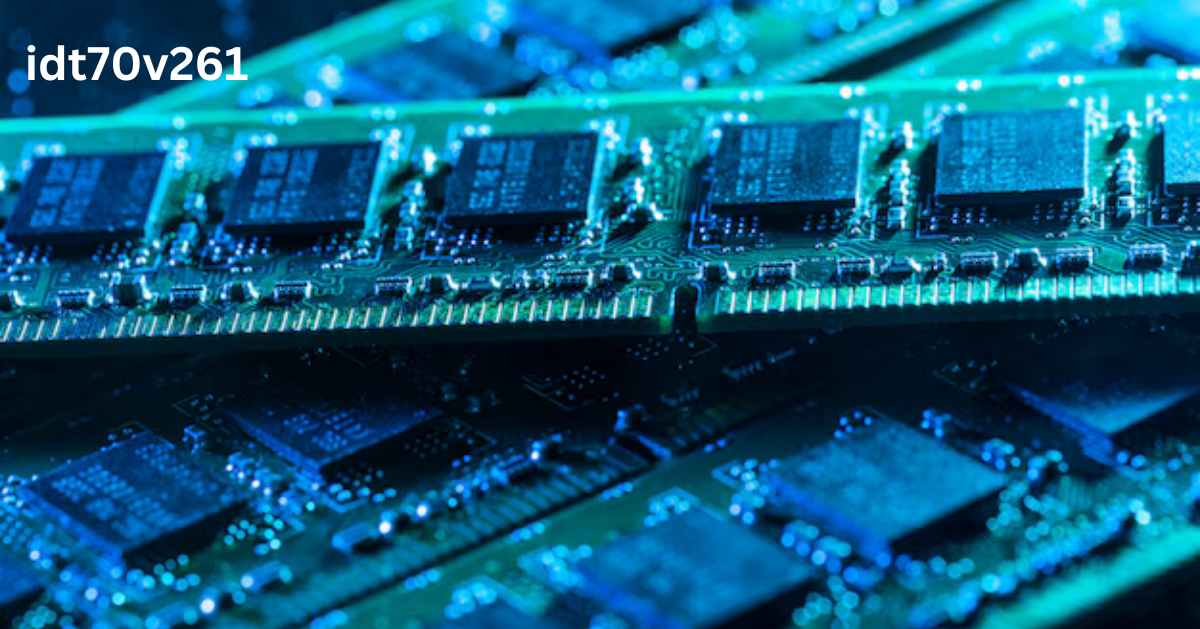Technology
“IDT70V261: Understanding the Fast Dual-Port 16K x 16 CMOS Static RAM”

The IDT70V261 is a high-speed, dual-port static RAM that plays a crucial role in applications requiring fast data access, synchronization, and communication between different system components. Known for its unique structure, this 16K x 16 CMOS RAM is designed with an additional 8 address locations allocated to binary semaphore flags, which enable multiple processors to communicate efficiently without data collisions. Here’s a comprehensive look at the IDT70V261’s capabilities, benefits, and usage in advanced computing applications.
Overview of the IDT70V261 Dual-Port Static RAM
The IDT70V261 is a high-speed CMOS static RAM that supports simultaneous read and write operations, thanks to its dual-port structure. This structure allows two devices to access memory independently, making it an ideal solution for systems with complex data processing needs, such as telecommunications, network processing, and real-time control.
Key Features of the IDT70V261
The IDT70V261 is designed to deliver robust performance in demanding applications. Key features include:
Dual-Port Access: Allows two devices to access memory at the same time without interference, facilitating efficient data transfer and processing.
16K x 16 Memory Array: Provides ample space for data storage, supporting up to 16K words of 16-bit data, which is ideal for many high-performance applications.
CMOS Technology: Operates with low power consumption while offering high speed, reliability, and reduced heat generation.
Semaphore Flags: Eight dedicated memory locations serve as semaphore flags, which are critical for managing communication between processors or other devices.
Dual-Port Memory and Its Importance
Dual-port memory architecture is central to the IDT70V261’s functionality. Unlike traditional single-port memory, dual-port memory allows two independent processors to access the RAM simultaneously. This setup is essential in systems requiring parallel processing, as it allows for efficient data exchange without causing delays or data corruption due to contention for memory access.
The Role of Semaphore Flags in the IDT70V261
Semaphore flags in the IDT70V261 provide a unique mechanism to avoid conflicts when multiple devices attempt to access shared resources. Each of the eight semaphore flags is a binary value used as a communication indicator, allowing processors to signal their control over certain memory segments or actions. This feature is particularly valuable in multi-processor systems where data integrity and synchronization are critical.
Benefits of IDT70V261 in Multi-Processor Systems
Enhanced Data Synchronization: Semaphore flags facilitate smoother data synchronization, reducing the risk of data conflicts in multi-processor environments.
High-Speed Operations: With its fast read/write capabilities, the IDT70V261 enhances processing speed, which is critical in high-demand applications like networking and telecommunications.
Low Power Consumption: CMOS technology minimizes power usage, ensuring that the IDT70V261 remains energy-efficient, even during intensive operations.
Improved System Reliability: By minimizing data conflicts and ensuring reliable synchronization, the IDT70V261 contributes to a more stable and dependable system.
Application Areas of the IDT70V261
The IDT70V261 is widely used in applications that require reliable data transfer and synchronization, especially in systems with multiple processors or devices. Key application areas include:
Telecommunications: Facilitates fast data handling and signal processing, essential for high-speed telecommunications infrastructure.
Networking Equipment: Enables efficient data exchange and handling in network routers, switches, and hubs, supporting high-throughput networking environments.
Industrial Control Systems: Provides reliable communication and synchronization between controllers and processors in industrial automation and control systems.
Medical Imaging Equipment: Ensures accurate data processing and coordination between different imaging components, critical in high-precision medical devices.
Comparing the IDT70V261 with Other RAM Types
The IDT70V261 stands out from traditional single-port RAM and even other dual-port options due to its built-in semaphore flags. Unlike standard dual-port memory, which lacks mechanisms for direct communication between devices, the IDT70V261’s semaphores act as a form of internal communication, allowing two systems to efficiently share resources without external control logic.
Technical Specifications of the IDT70V261
- Memory Size: 16K x 16, providing a total memory capacity of 256K bits.
- Access Time: Typically offers access times of 15 to 25 nanoseconds, making it a high-speed memory solution.
- CMOS Process Technology: Built on CMOS technology, which ensures low power consumption and high noise immunity.
- Data Retention Voltage: Capable of retaining data at low voltages, improving power efficiency in standby modes.
- Operating Temperature Range: Available in commercial and industrial temperature ranges, enhancing its suitability for various environments.
Understanding the Memory Access Protocol in the IDT70V261
The IDT70V261’s memory access protocol enables independent memory access by two devices without interference. In cases where simultaneous access to the same memory location is attempted, the device uses a priority scheme to manage access. This design prevents data corruption and maintains data integrity.
Benefits of Using Semaphore Flags in Dual-Port RAM
Semaphore flags serve as a form of communication between devices, signaling when a memory location is being used by one processor, so the other knows to avoid accessing it. This feature significantly reduces data conflict and ensures seamless data sharing between devices.
Potential Limitations of the IDT70V261
While the IDT70V261 offers many advantages, it does have some limitations, including:
Limited Memory Size: With a 16K x 16 configuration, it may not be suitable for applications requiring larger memory capacities.
Dependency on Semaphore Mechanism: For systems requiring extensive inter-device communication, the semaphore flag system may require additional programming to optimize its performance.
The Importance of Power Efficiency in the IDT70V261
The IDT70V261 is designed for low power consumption, which is critical in applications where energy efficiency is a priority. CMOS technology helps reduce power usage during both active and standby modes, making it ideal for systems where continuous operation is essential without high power costs.
Ensuring Data Integrity with the IDT70V261
Data integrity is a core benefit of the IDT70V261. By using semaphore flags to manage data access and synchronization, the device minimizes the risk of data corruption, which is essential in applications where accuracy and reliability are paramount.
IDT70V261 in Real-Time Applications
Real-time applications such as communication systems, industrial automation, and medical devices require instantaneous data processing. The IDT70V261’s dual-port capability and fast access times make it suitable for these applications, ensuring timely and accurate data processing.
Setting Up and Configuring the IDT70V261
To use the IDT70V261 effectively, it’s crucial to configure its ports and semaphore flags properly. This configuration ensures optimal data flow between processors and allows systems to benefit fully from the device’s unique features.
Advantages of IDT70V261 for Engineers and Designers
For system designers, the IDT70V261 provides a high-speed, low-power, and reliable memory solution that supports complex applications. Its dual-port nature and semaphore mechanism simplify design and improve efficiency, allowing engineers to focus on other aspects of system development.
Conclusion
The IDT70V261 is a robust, dual-port static RAM solution with advanced features like semaphore flags that enable efficient communication between multiple devices. Its low power consumption, high-speed performance, and efficient memory access protocols make it ideal for applications across telecommunications, networking, industrial automation, and medical imaging. By facilitating seamless data synchronization, the IDT70V261 addresses the needs of high-performance systems where reliability and speed are essential.
FAQs
What makes the IDT70V261 suitable for multi-processor systems?
Its dual-port structure and semaphore flags enable efficient data access and synchronization, critical for multi-processor systems.
How do semaphore flags work in the IDT70V261?
Semaphore flags are binary indicators that signal when a processor is using specific memory, preventing data conflicts.
What is the memory capacity of the IDT70V261?
It has a 16K x 16 configuration, providing a total of 256K bits of memory.
What applications commonly use the IDT70V261?
It’s used in telecommunications, network processing, industrial control systems, and medical imaging due to its high-speed, reliable performance.
How does the IDT70V261 support low power consumption?
Built on CMOS technology, it uses low power in both active and standby modes, enhancing energy efficiency.
Technology
wavr-297: Revolutionizing Technology

As time goes on, new technological developments expand the limits of what was previously considered feasible. Wavr-297 stands out among these breakthroughs as one that is really fascinating. To appreciate Wavr-297’s potential influence across multiple areas, it is vital to understand its relevance.
What is wavr-297?
Wavr-297 is a state-of-the-art technological marvel, marking a watershed moment in the convergence of VR and AR. By fusing the digital and physical realms, it provides users with an unprecedented level of immersion.
History and Background
Wavr-297 was born because of the merging of virtual reality and augmented reality. It has evolved into the groundbreaking platform it is today because of years of dedicated research and development.
Features of wavr-297
Fundamentally, Wavr297 has a plethora of functions made to enthrall and involve users. Redefining the bounds of reality, it features interactive worlds and breathtaking visual displays.
How does wavr-297 work?
By superimposing digital material over the user’s actual surroundings, Wavr297 makes it difficult to tell the difference between reality and the virtual world. Its cutting-edge algorithms make sure everything works together smoothly, giving you an immersive experience.
Applications of wavr-297
Among the many fields that can benefit from Wavr297’s adaptability are the gaming, educational, healthcare, and business spheres. Its uses are practically endless, ranging from improving training simulations to transforming the entertainment industry.
Advantages of wavr-297
More so than with older VR or AR devices, it provides a natural and intuitive experience.
Challenges and Limitations
There are certain difficulties with the Wavr297, despite its impressive capabilities. Problems with hardware compatibility and high costs might prevent broad use in several industries.
Future prospects
Wavr297 seems to have a bright future ahead of it. We may anticipate that technological advancement will be driven by more inventions and refinements.
Comparison with Similar Technologies
The innovative capabilities and superior user experience of the Wavr297 make it stand out from competing virtual reality and augmented reality systems.
User Experience with wavr-297
Users have been quite complimentary, with many applauding the game’s realistic graphics and immersive experience. Wavr297 has received a lot of praise from both gamers and pros.
Industry Adoption
Recognizing Wavr297’s revolutionary potential, several sectors have started to adopt it. It is having an effect in many fields, from architectural visualization to training simulations.
Regulatory Considerations
Wavr297, like any new technology, brings up serious moral and legal questions. The future of it will be greatly influenced by regulations about privacy and content management.
Cost and Accessibility
Despite Wavr-297’s exceptional experiences, its accessibility and affordability are major factors preventing its broad adoption. In order to make this revolutionary technology accessible to more people, it is crucial to work towards lowering entrance barriers.
Conclusion
Virtual and augmented reality have undergone a sea change with Wavr297. It is poised to lead the way in creating the future of immersive technology thanks to its novel features and prospective uses.
FAQs
Is wavr-297 compatible with existing VR and AR hardware?
The smooth operation of your virtual reality and augmented reality headsets will be guaranteed by Wavr-297’s compatibility with a broad variety of devices.
Can wavr-297 be used for educational purposes?
Virtual field tours and interactive learning experiences are only two of the many educational uses for Wavr297.
How does wavr-297 differ from traditional VR and AR systems?
The enhanced features and unsurpassed realism of the Wavr297 make it stand out and provide consumers with a more realistic experience.
What industries are currently adopting wavr-297?
Many sectors are using Wavr297, including the gaming, healthcare, educational, and business sectors.
Technology
How Blockchain is Revolutionizing Data Security and Online Transactions

With the rise of cyber threats, data breaches, and fraudulent online transactions, businesses and individuals are increasingly seeking secure ways to protect their sensitive information. Blockchain technology has emerged as a game-changing innovation that enhances data security and revolutionizes online transactions. By providing decentralization, transparency, and cryptographic security, blockchain has the potential to transform multiple industries, from banking and finance to healthcare and e-commerce.
In this comprehensive blog, we will explore how blockchain technology is reshaping data security and online transactions, its benefits, challenges, and real-world applications. Additionally, we will discuss the future of blockchain and answer key FAQs.
Understanding Blockchain Technology
What is Blockchain?
Blockchain is a decentralized, distributed ledger technology that records transactions in a secure and transparent manner. Unlike traditional databases managed by a single entity, blockchain operates on a peer-to-peer network, making it resistant to fraud and hacking.
How Does Blockchain Work?
A blockchain consists of blocks of data linked together in a chain. Each block contains:
- A list of transactions
- A timestamp
- A cryptographic hash of the previous block
This structure ensures immutability, meaning once data is recorded, it cannot be altered or deleted. The consensus mechanism (Proof of Work, Proof of Stake, etc.) validates each transaction, preventing unauthorized changes.
Key Features of Blockchain
- Decentralization – No central authority controls the blockchain.
- Transparency – All transactions are recorded on a public ledger.
- Security – Data is protected using cryptographic techniques.
- Immutability – Once recorded, data cannot be changed.
- Smart Contracts – Automated contracts execute transactions when conditions are met.
How Blockchain Enhances Data Security
1. Data Encryption and Cryptographic Security
Blockchain employs advanced encryption and hashing algorithms (such as SHA-256) to secure data. This makes it nearly impossible for hackers to tamper with or alter stored information.
2. Decentralization Reduces Single Points of Failure
Traditional databases are centralized, making them vulnerable to cyberattacks and data breaches. In contrast, blockchain operates on multiple nodes across a network, eliminating single points of failure.
3. Immutable and Tamper-Proof Records
Once a transaction is verified and recorded on a blockchain, it cannot be modified. This immutability ensures data integrity and prevents fraudulent activities such as identity theft and financial fraud.
4. User Anonymity and Privacy Protection
Blockchain enables users to make transactions without exposing personal information. While transactions are transparent, user identities remain encrypted and anonymous.
5. Secure Access Control and Authentication
Blockchain-based identity management systems provide multi-factor authentication and biometric security, reducing the risk of unauthorized access and identity fraud.
How Blockchain is Revolutionizing Online Transactions
1. Faster and Cost-Effective Payments
Blockchain eliminates intermediaries, such as banks and payment processors, making transactions faster and cheaper. Cross-border payments, which traditionally take days, can be completed in minutes using blockchain.
2. Smart Contracts for Automated Transactions
Smart contracts are self-executing contracts stored on the blockchain. These contracts automatically process transactions when predefined conditions are met, reducing the need for manual verification and middlemen.
3. Fraud Prevention in Digital Transactions
With blockchain, transactions are securely recorded, preventing double-spending, chargeback fraud, and identity theft.
4. Secure E-commerce and Online Marketplaces
Blockchain-powered e-commerce platforms provide transparent, tamper-proof records, reducing counterfeit goods, fake reviews, and fraudulent activities.
5. Decentralized Finance (DeFi) and Cryptocurrency
The rise of cryptocurrencies like Bitcoin and Ethereum has led to a new financial ecosystem called DeFi (Decentralized Finance). DeFi eliminates traditional banks, allowing peer-to-peer lending, borrowing, and investing through blockchain.
Real-World Applications of Blockchain in Data Security and Transactions
1. Banking and Finance
- Secure digital payments (Bitcoin, Ethereum, Ripple)
- Fraud detection and risk management
- Cross-border transactions without high fees
2. Healthcare
- Secure patient records and medical history
- Protection against data breaches
- Blockchain-based drug tracking and supply chain management
3. Supply Chain Management
- Transparency and traceability in supply chains
- Preventing counterfeit goods
- Reducing fraud in logistics
4. Identity Verification and Management
- Digital IDs on blockchain
- Preventing identity theft and cyber fraud
- Secure voting systems in elections
5. E-commerce and Retail
- Fraud-free online shopping
- Transparent and verifiable product origins
- Secure customer transactions
Challenges and Limitations of Blockchain
1. Scalability Issues
As blockchain networks grow, transaction speed and scalability become concerns. Solutions like Layer 2 scaling (Lightning Network, Ethereum 2.0) are being developed to address this issue.
2. Energy Consumption
Some consensus mechanisms, like Proof of Work (PoW), require massive computational power, leading to high energy consumption.
3. Regulatory and Legal Concerns
Governments are still working on regulations for blockchain and cryptocurrencies, leading to uncertainty in adoption.
4. Adoption Challenges
Many industries are hesitant to adopt blockchain due to technical complexities and lack of understanding.
The Future of Blockchain in Data Security and Transactions
Blockchain is set to become a mainstream technology in securing online transactions and sensitive data. Future trends include:
- Mass adoption of DeFi platforms
- Integration of AI and blockchain for enhanced security
- Green blockchain solutions with lower energy consumption
- Increased regulatory clarity for global blockchain adoption
- Growth in NFT and tokenization of digital assets
FAQs
1. How does blockchain enhance data security?
Blockchain uses encryption, decentralization, and immutability to ensure data integrity and protection against cyber threats.
2. Can blockchain prevent online fraud?
Yes, blockchain’s transparent and tamper-proof records make it difficult for fraudsters to alter or fake transactions.
3. Are blockchain transactions completely anonymous?
While blockchain transactions are transparent, user identities remain encrypted and pseudonymous.
4. What industries benefit most from blockchain security?
Banking, healthcare, supply chain, e-commerce, and identity verification industries benefit significantly from blockchain.
5. Is blockchain expensive to implement?
Initial implementation can be costly, but over time, blockchain reduces operational costs by eliminating intermediaries and automating processes.
6. Can blockchain be hacked?
While blockchain is highly secure, certain vulnerabilities, such as 51% attacks and smart contract bugs, need to be addressed.
Conclusion
Blockchain technology is redefining data security and online transactions, offering a decentralized, secure, and efficient alternative to traditional systems. As businesses and industries continue to adopt blockchain, the world moves toward a more transparent, fraud-resistant, and secure digital future.
While challenges remain, ongoing advancements and regulatory frameworks will further solidify blockchain as a revolutionary force in data security and finance. If you’re looking for a secure, efficient, and future-proof solution for digital transactions, blockchain is undoubtedly the way forward!
Technology
DTF Printing Process Analysis: A Complete Guide from Design to Finished Product

Direct-to-Film (DTF) printing has revolutionized textile and garment decoration. It offers unmatched versatility and exceptional print quality. DTF technology lets businesses make detailed, vibrant, and durable designs on various materials. It works on custom T-shirts, hats, bags, and other accessories. This guide analyzes the DTF printing process in detail. It covers everything from the design stage to the final product. You will understand each step for a successful print job.
For the best results, use high-quality materials. Use the best DTF transfer film and reliable equipment. This guide will discuss the importance of these components. They are key to the success of your DTF printing efforts.
Understanding the DTF printing process:
DTF printing is a digital transfer method. It prints designs on a special film using DTF-compatible inks. The process involves using heat and pressure to transfer the design from the film to the fabric. It is a vibrant, durable design. It adheres to various fabrics, including cotton, polyester, and blends.
Key Advantages of DTF Printing:
- Works on a wide range of materials.
- Produces vibrant colors and fine details.
- Offers excellent durability and wash resistance
- Eliminates the need for costly screen setups.
Step-by-Step DTF Printing Process:
Step 1: Creating the Design:
The process begins with designing the artwork. Use graphic design software like Adobe Illustrator or Photoshop to create high-resolution designs. Ensure the following:
- The design resolution is 300 DPI or higher.
- ICC profiles optimize colors for the best color accuracy.
- The design has a transparent background for clean transfers.
Step 2: Printing the design on DTF film:
Use a DTF printer to print the design onto the best DTF transfer film. This film has a special coating. It holds the ink and transfers it to the fabric very well.
- Printer Setup: Load the film into the printer. You must position it for single-sided printing.
- Printing Process: The printer first applies colored ink to the film. Then, it adds a layer of white ink for opacity.
- Film Selection: Choose high-quality films, like cold or hot peel types, based on your needs. Cold peel films are best for precision. Hot peel films process faster.
Step 3: Applying Hot Melt Powder:
After printing, apply a fine layer of hot melt adhesive powder to the wet ink. This powder acts as a bonding agent during the heat transfer process.
- Application Tips: Spread the powder in a uniform manner to avoid uneven bonding.
- Curing Process: Use a curing oven or heat press to melt the powder and solidify the design.
- Step 4: Transferring the design onto fabric:
Place the DTF film on the fabric, with the printed side facing down. Use a heat press to transfer the design.
Heat Press Settings:
- Temperature: 160-180 °C (320-356 °F)
- Pressure: Medium to high.
- Time: 15-20 seconds.
Peeling the film:
Depending on the film type, peel it off either immediately (hot peel) or once it cools down (cold peel).
Step 5: Post-Pressing:
For durability, press the design with a protective sheet for 5 to 10 seconds. This step ensures better adhesion and a smoother finish.
Components of the DTF printing process:
DTF Transfer Film:
The DTF transfer film is a critical component of the process. It acts as the carrier for the design and ensures a clean transfer to the fabric. LINKO’s high-quality films provide better print clarity and durability. They are also easier to use.
Types of DTF films:
- Cold Peel Film: Requires cooling before peeling, offering better precision.
- You can peel Hot Peel Film right after pressing. It’s ideal for fast production.
- You can peel the Instant Peel Film at any time, but it requires careful handling.
DTF Ink:
Designers create DTF-specific inks for vibrant color reproduction and durability. They form a deep bond with the film and fabric. They provide lasting results.
Hot Melt Powder:
This adhesive powder ensures the design adheres to the fabric. The powder’s quality affects the print’s durability and wash resistance.
Choosing the Right Materials and Equipment:
Best DTF Transfer Film:
Investing in the best DTF transfer film is crucial for high-quality prints. LINKO’s films have a smooth surface, high ink absorption, and great transfer performance.
DTF Printers:
Choose printers that offer precision and efficiency. Popular options include Epson-based DTF printers with many printheads for faster production.
Software and Color Management:
Use advanced RIP software to manage color accuracy and ink distribution. Experts recommend software like Print Factory. The interface is easy to use, and the features are robust.
Common Issues and Troubleshooting:
Despite its advantages, DTF printing can face challenges.
Here’s how to address some common problems:
Poor adhesion: Ensure even powder application and proper heat press settings.
Color Mismatch: Use correct ICC profiles and high-quality inks.
Film Sticking to Fabric: Adjust heat and pressure settings to prevent over-pressing.
Applications of DTF printing:
You can use DTF printing for a wide range of products, including:
- Custom apparel (T-shirts, hoodies, jackets).
- Accessories (hats, bags, shoes).
- Promotional items (banners, flags).
- Its ability to work on various materials makes it a top choice for businesses that want to diversify.
Maintenance and Storage Tips:
- Storage Conditions: Keep DTF films in a cool, dry place to prevent moisture damage.
- Printer maintenance: clean daily print heads and use high-quality ink to avoid clogging.
- Film handling: Avoid scratching or creasing the film for consistent results.
Why choose LINKO for DTF printing supplies?
LINKO is a trusted name in DTF printing. We offer printers, inks, powders, and the best DTF transfer film. With years of experience, www.dtflinko.com helps businesses in the printing market. It is very competitive. We provide innovative solutions and exceptional customer support.
Conclusion:
DTF printing is a game changer in textiles. It offers unmatched flexibility and quality. Using the best DTF transfer film and knowing the process can yield stunning results. This will help grow your business.
This guide will help you, whether you’re a pro or a beginner. It will make your DTF printing efficient, reliable, and profitable.


















